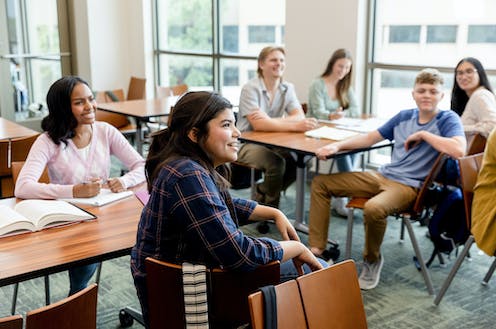
Concerns about what is or isn’t legal can hinder objective lessons about religious studies in class. SDI Productions/E+ via Getty Images
Despite the holiday season’s calls for joy and peace, religious strife continues in many places. While the United States has a great deal of litigation and controversy over religion’s place in public life, it has largely avoided violence. Yet our society often seems unprepared to talk constructively about this contentious topic, especially in schools.
According to the IDEALS survey of college students on 122 U.S. campuses, conducted by researchers at North Carolina State University, Ohio State University and the nonprofit Interfaith America, just 32% of students said they had developed the skills “to interact with people of diverse beliefs.” Although almost three-quarters of students spent time learning about people of different races, ethnicities or countries, less than half of them reported learning about various religions. Most students received “C” grades or below on the survey’s religious literacy quiz.
Objective education about the world’s religions has the potential to foster tolerance and understanding, and various research groups provide guidelines for religious literacy education. Yet the study of religion may be hindered by hesitation about what is and isn’t legal in public classrooms – a topic I write about often as a professor of law and education, with a particular interest in these fields’ relationships to religion.
Other countries also face challenges in deciding what kind of religion-related instruction can or can’t be legally taught in public schools, and each deals with the question in different ways.
Students attend their last class before mid-term holidays begin in April 2023 in Ankara, Turkey.
Ercin Erturk/Anadolu Agency via Getty Images
US legal landscape
Though there have been many Supreme Court cases over issues of church and state in public schools, most deal with the First Amendment freedoms of students, staff and parents rather than what’s officially taught in class.
There has been relatively little litigation about what teachers can and can’t instruct students in matters that touch on religion. Two of the exceptions involved lessons about evolution: one decided in 1968, the other in 1987. In both cases, the Supreme Court upheld educators’ right to teach evolution, rather than the biblical accounts of creation, to explain human origins.
Federal trial courts in Mississippi and Florida banned courses in the 1990s that included instruction about the New Testament, ruling that the way they were taught crossed a line and violated the establishment clause of the U.S. Constitution. However, this was because the courts determined instruction was being given from a Christian perspective. The court in Florida did allow teaching about the Hebrew scriptures, because the focus was on the texts’ cultural and literary significance.
In the Supreme Court’s closest response to the question of teaching about religion in public schools, 1963’s School District of Abington Township v. Schempp, eight of the nine justices agreed that state-sponsored prayer and Bible reading in public schools violates the establishment clause. Yet the court recognized that “the Bible is worthy of study for its literary and historic qualities. Nothing we have said here indicates that such study of the Bible or of religion, when presented objectively as part of a secular program of education, may not be effected consistently with the First Amendment.”
The court’s decision “plainly does not foreclose teaching about the Holy Scriptures or about the differences between religious sects in classes in literature or history,” Justice William Brennan added in a concurrence. Thus, consistent with religious literacy programs’ approach, public schools can teach about religion, but not in ways that seek to instill systems of belief.
International perspectives
To place the issue in perspective, it is worth highlighting other countries’ approaches to teaching about religion in the classroom – the focus of a book I recently edited.
At one end of the 18 countries examined in the book, educators in Mexico impose significant restrictions on what can be taught about faith-based beliefs. According to the Mexican Constitution, “State education shall be maintained entirely apart from any religious doctrine.” However, it does allow religious institutions to provide faith-based education through the private schools they sponsor.
Most nations the book analyzes are more open to teaching about religion in public schools as long as instruction remains objective and does not indoctrinate students. Australia, Brazil, Canada, Hungary, Italy, the Netherlands, Poland, South Africa and Sweden all adopt this approach in varying degrees.
For example, according to the Brazilian Constitution, optional religious education should be offered during the day for elementary students. The country’s National Education Act describes this as a way of “ensuring respect for Brazil’s religious cultural diversity, and any form of proselytism is prohibited.”
Brazilian President Luiz Inacio Lula da Silva (in tan suit) and Minister of Education Camilo Santana attend the launch of the literacy program for schoolchildren.
Mateus Bonomi/Anadolu Agency via Getty Images
Australia allows nondenominational classes about religion to help students understand the “influence of religion in life and society and the variety of beliefs by which people live.” In addition, it permits faith-based student clubs, as well as religious seminars that amount to no more than one half day per term. Parents can ask that their children be excused, or students may participate in ethics courses instead.
At the other end, England, Malaysia and Turkey mandate teaching about religion in public schools, though British parents may exempt their children. England’s Department for Children, Schools and Families strongly encourages that instruction include multiple religious perspectives, while classes in the other two countries are allowed to be more from faith-based perspectives.
Malaysia, which declares Islam the official religion, mandates faith-based instruction on Islam for Muslim students. Non-Muslims must attend moral studies classes. Turkey, meanwhile, requires religious culture and moral knowledge courses for grades 4-12 that focus on Islam. Parents who belong to other religions have the right to exempt their children from these classes.
What happens in public schools in the U.S. today will significantly shape tomorrow’s society. I believe encouraging teaching about religion can help America’s rapidly diversifying population to understand and respect others’ beliefs or lack thereof. Discussing religions in an inclusive, objective and academic way can certainly be challenging in a classroom, as there is a fine line between teaching about it and proselytizing – but not doing so has risks as well.
Charles J. Russo does not work for, consult, own shares in or receive funding from any company or organization that would benefit from this article, and has disclosed no relevant affiliations beyond their academic appointment.
Advertisement

Advertisement
Contact Us
If you would like to place dofollow backlinks in our website or paid content reach out to info@qhubonews.com











